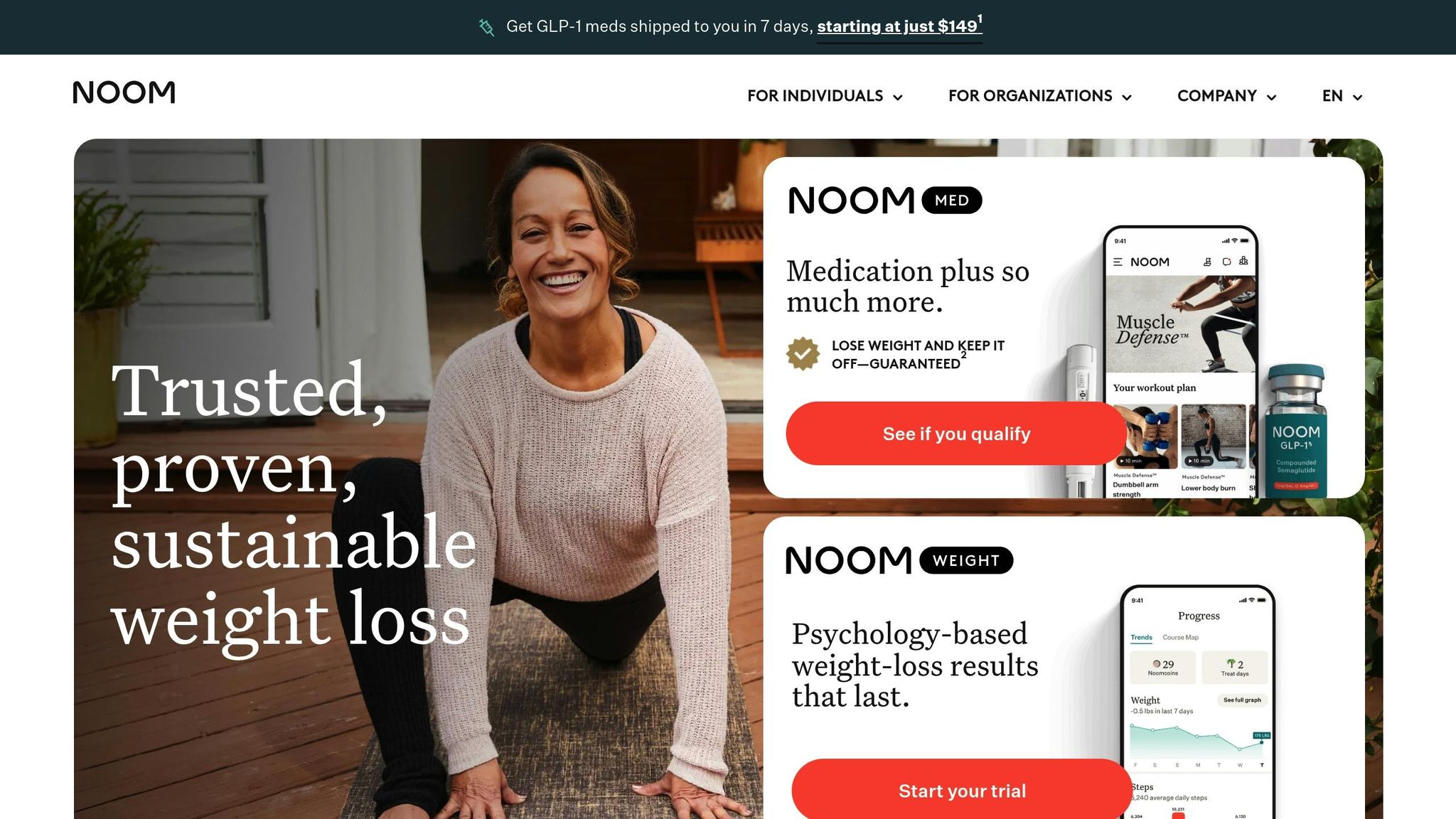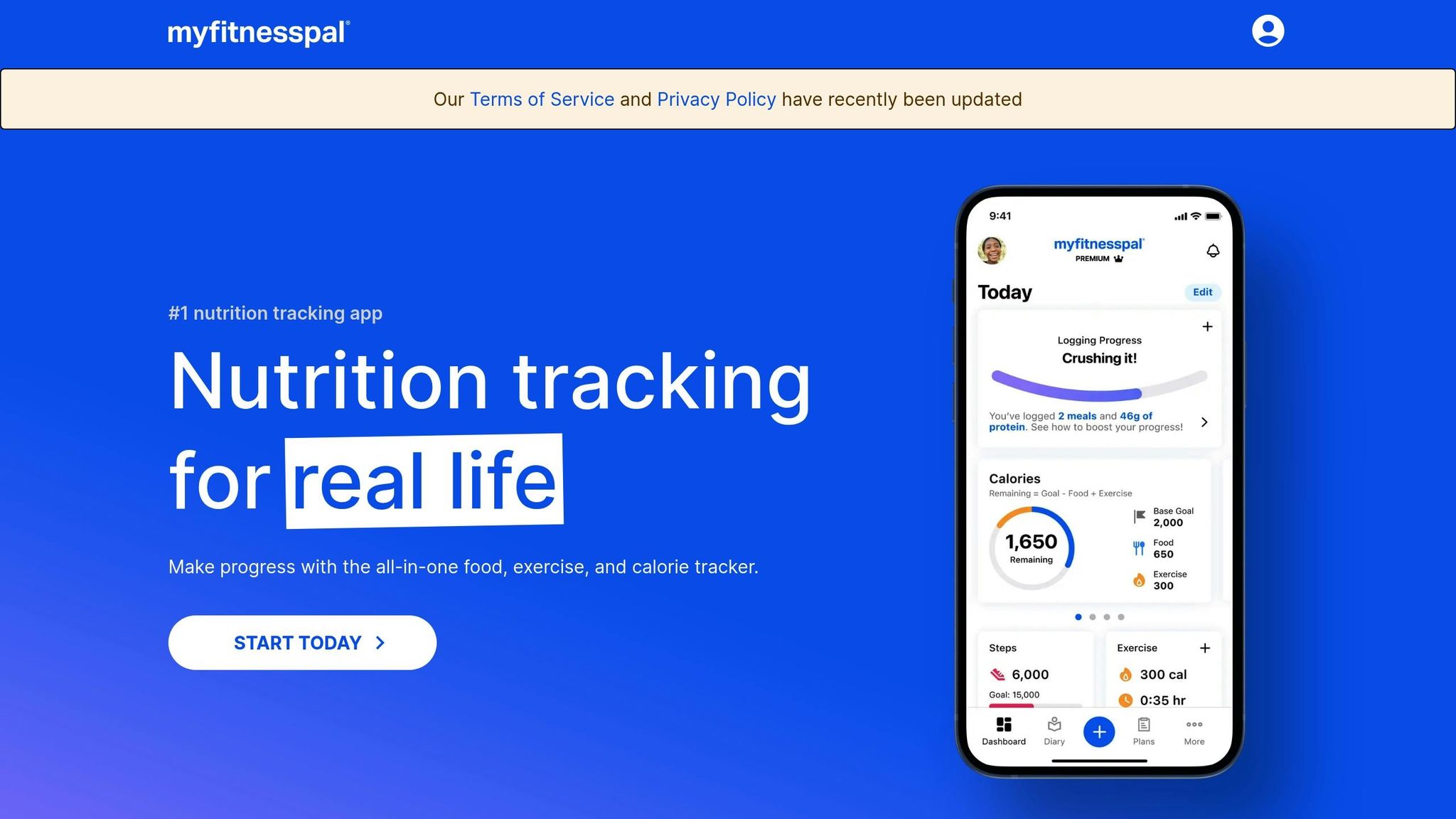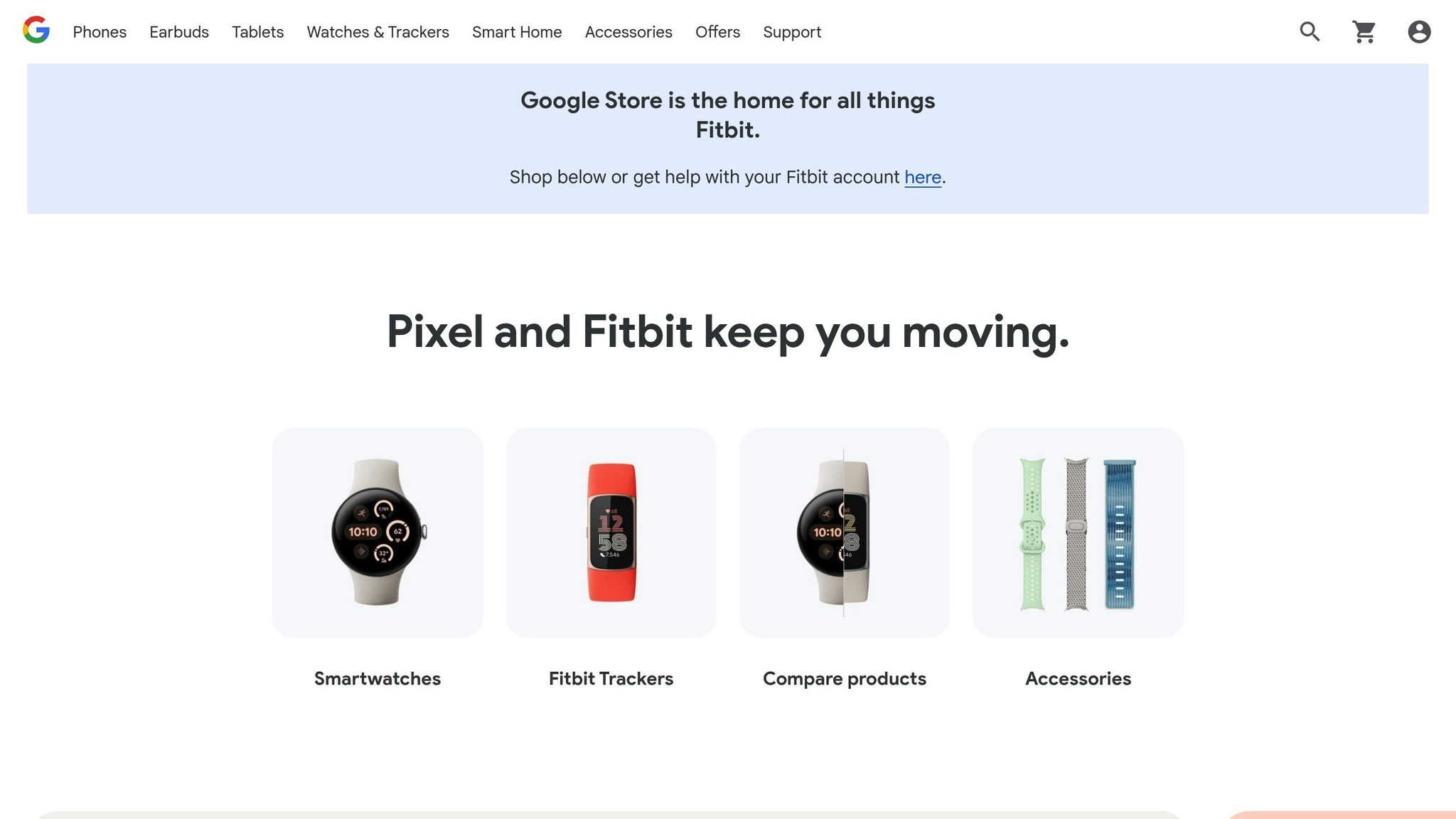
AI Habit Trackers for Weight Loss: What Works and What Doesn’t
AI habit trackers are changing how people approach weight loss by automating tracking, offering personalized guidance, and addressing common challenges like motivation and adherence. Here's what you need to know:
- Top AI Tools: Noom, MyFitnessPal, Fitbit, and Ember.
- Key Features: Automated tracking, real-time advice, predictive analytics, and personalized goals.
- Effectiveness: Users report weight loss between 2.4%–4.7% of body weight in 3–16 weeks.
- Challenges: Over-reliance on AI, notification fatigue, and environmental factors like overeating triggers.
Quick Comparison
| Tool | Key Features | Pricing |
|---|---|---|
| Noom | Psychology-based, virtual coaching, food tracking | $70/month |
| MyFitnessPal | Calorie tracking, macro goals, app sync | $19.99/month (Premium) |
| Fitbit | Fitness tracking, sleep insights, health metrics | $9.99/month (Premium) |
| Ember | Daily AI calls, emotional health focus | Custom pricing |
AI tools can simplify weight loss, but success depends on consistent use and pairing with proven strategies. Choose the one that fits your lifestyle and preferences.
Top 5 AI Apps for Losing Weight 2023
1. Noom

Noom takes a psychology-first approach to weight loss, combining behavioral science with traditional tracking tools to create tailored programs for its users.
A 2016 study involving 35,921 Noom users revealed that 77.9% lost weight over an average of 267 days (about nine months), with 22.7% shedding more than 10% of their starting weight.
This success stems from Noom's mix of technology and behavioral insights, delivered through three main features:
-
Smart Food Classification: Noom uses a color-coded system to categorize foods as green, yellow, or orange based on their calorie and nutrient density. This helps users make better choices without feeling overly restricted. Dietitian Kelli McGrane notes:
"While any food tracking can lead to obsessive habits and an unhealthy relationship with food, I appreciate that Noom's color-coded system gets away from the idea that calories are the be-all and end-all when it comes to weight loss and healthy eating."
- Personalized Analytics: Noom’s algorithm tailors daily calorie goals based on individual traits and lifestyle. Features like the Welli assistant, 360 Body Scan, Noom Vibe, and Noom Move enhance this customization.
- Behavioral Support: The app offers certified virtual coaches, a 16-week Noom Mood program for managing stress, daily educational lessons, and a reward system called Noomcoin to keep users motivated.
Research highlights that consistent engagement, such as logging meals and tracking weight regularly, leads to better results. Most users lose 1-2 pounds per week. However, McGrane advises caution:
"Because Noom is a weight loss app, it's not uncommon for the algorithm to set a calorie goal that's initially too low for your needs."
User Ratings:
- iOS: 4.7/5
- Android: 4.4/5
- Healthline: 4.3/5
Pricing: Noom costs $70 per month or $209 annually. Noom Med, which includes additional features, is available for $49 per month (excluding medication costs).
Noom's Key Features at a Glance
| Feature | How It Works | Benefit to Users |
|---|---|---|
| Tracking | Automated food logging with the Welli assistant | Simplifies meal tracking |
| Support | Virtual coaching from certified professionals | Provides accountability in real time |
| Progress | Regular updates and reports | Helps users adjust and stay on track |
| Education | Daily personalized lessons | Promotes lasting behavior change |
Noom’s combination of data, psychology, and AI-driven tools has made it a leader in weight loss apps, holding the top spot in the Google Play store's health and fitness category since 2012.
2. MyFitnessPal

MyFitnessPal offers a weight management platform with tools for tracking food and exercise. With a database of 18 million foods and over 200 million users, it has helped members collectively lose more than 180 million pounds.
Key Features Powered by AI
-
Personalized Goal Setting
Using the Mifflin St. Jeor equation, MyFitnessPal calculates your Base Metabolic Rate (BMR). It sets tailored nutrition targets based on factors like height, weight, age, biological sex, activity levels, and desired weight change. -
Smart Tracking System
This app goes beyond simple calorie counting. It syncs with over 35 fitness apps and devices, automates exercise and step tracking, monitors water intake, supports intermittent fasting, and provides detailed macro and micronutrient data. -
Learning Your Habits
Over time, MyFitnessPal remembers your regular meals and workouts, making tracking easier.
| Feature | Free Version | Premium Version |
|---|---|---|
| Calorie Tracking | ✓ | ✓ |
| Basic Macro Tracking | ✓ | ✓ |
| Barcode Scanner | Limited | Unlimited |
| Custom Macro Goals | × | ✓ |
| Intermittent Fasting Tracker | × | ✓ |
Challenges Users Face
While the app has many strengths, there are some drawbacks. Exercise calorie estimates can be off by as much as 60%. Its default calorie deficits may be overly aggressive, tracking restaurant meals can be tricky, and the color-coded system (red/green) might lead to negative associations.
Dietitian Stephanie Nelson highlights:
"Studies show people who keep a food diary are more likely to hit their goals. MyFitnessPal simplifies nutrition and calorie tracking, provides the data you want, and helps you make sense of it all."
Tips for Getting the Most Out of MyFitnessPal
- Adjust calorie goals using this formula: Body Weight (lbs) × 12
- Turn off exercise data syncing to avoid eating back too many calories
- Add 30% to calorie estimates for restaurant meals
- Limit tracking to 4–6 months to avoid burnout
Personal trainer Adam Berry adds:
"It's not obsessive to want to learn more about something - just remember this isn't a life sentence, this is an education to lead you to be more confident and empowered for the future."
With 3.7 million 5-star reviews, MyFitnessPal has a strong reputation. However, one study noted no significant difference in weight loss between app users and those following standard care. Success depends on consistent use and applying its features effectively.
sbb-itb-09f2e92
3. Fitbit

Fitbit has helped millions work toward their weight loss goals using AI-driven tracking and data insights. With over 63 million devices sold worldwide, Fitbit combines reliable hardware with smart software features.
AI-Driven Weight Loss Tools
Fitbit devices provide accurate tracking of daily metrics while analyzing activity patterns and biometric data to set realistic goals. Research shows that setting goals can increase daily steps by about 950 and add over 6 minutes of moderate-to-vigorous activity, leading to an average weight loss of 1.48 pounds. These core features are enhanced by premium tools that further support overall health management.
| Premium Feature | Function | Benefit |
|---|---|---|
| Daily Readiness Score | Analyzes sleep, activity, and heart rate variability | Provides tailored workout recommendations |
| Advanced Sleep Tools | Tracks sleep stages and patterns | Helps improve recovery through sleep insights |
| Detailed Health Metrics | Monitors heart rate, breathing rate, and more | Offers deeper health tracking |
Clinical Backing
Clinical studies back Fitbit's effectiveness. A meta-analysis found that Fitbit interventions significantly increased daily steps (mean difference: 950.54, 95% CI: 475.89–1425.18; P<.001) and moderate-to-vigorous activity (mean difference: 6.16 minutes, 95% CI: 2.80–9.51; P<.001).
Premium Subscription
Fitbit Premium is available for $9.99 per month or $79.99 annually, offering advanced insights and personalized workout plans.
Things to Keep in Mind
While Fitbit offers valuable tools, results may vary between users. Some studies suggest that tracker-based interventions work best when combined with additional support like education or counseling.
Pricing Details
The Fitbit Charge 6 starts at $159.95, with financing options starting at $13.33 per month. This includes a trial of Fitbit Premium.
Health experts often recommend pairing Fitbit's features with clear goal-setting and regular progress tracking. Its real-time feedback can be a powerful tool for maintaining a healthier lifestyle.
4. Ember - Daily AI Calls for Weight Loss

Ember uses daily AI-powered phone calls to create a structure of accountability and habit-building. This approach combines conversational AI with personalized care to help users achieve weight loss goals.
Daily AI Check-in System
Ember's daily calls go beyond standard app notifications, offering a more engaging way to stay on track. These calls focus on key areas like meal planning, exercise, emotional health, and tracking progress.
Proven Results
Here’s what users have experienced:
| Metric | Result |
|---|---|
| Average Weight Loss | 2.4% (about 5.3 lbs) |
| Success Rate | 75.7% of users lost weight |
| Healthy Meal Increase | 31% improvement |
| Unhealthy Meal Reduction | 54% decrease |
| Average Engagement | 103 sessions over 15 weeks |
The average weight loss of 2.4% aligns closely with the 2.3% reported in the CDC's Web-based lifestyle program. Aside from these numbers, Ember also focuses on tailored behavioral guidance.
Personalized Support Features
Ember includes elements of cognitive behavioral therapy to offer:
- Real-time advice on food and drink choices
- Customized educational materials
- Progress tracking and self-reflection tools
- Support for specific diets (like keto or intermittent fasting)
- Access to on-demand coaching calls
Interactive Engagement
Motivation is maintained through regular goal-setting discussions, activity tracking, personalized feedback, and occasional SMS updates.
Features and Limitations
AI trackers work best when equipped with the right tools. Here's a breakdown of their strengths and challenges based on research.
Personalization and Flexibility
These platforms can improve self-monitoring, set better goals, and encourage gradual progress. Here's how some key features perform:
| Feature | Impact on Weight Loss | Limitation |
|---|---|---|
| Machine Perception | Improves tracking accuracy | May still need manual input |
| Predictive Analytics | Adjusts goals based on user history | Depends on quality of data |
| Real-time Analytics | Reduces behavioral lapses | May lead to notification fatigue |
| Micro-interventions | Helps with steady progress | Effectiveness varies by user |
These tools help keep users engaged by tailoring the experience to their needs.
Engagement and Retention
Retention rates for these platforms range between 44% and 86%. Factors that influence long-term use include well-timed prompts, easy integration into daily routines, user-friendly interfaces, and support for behavior changes.
Effectiveness Metrics
Studies show that users lose an average of 2.4%–4.7% of their body weight over 3–16 weeks, with program completion rates aligning with the retention figures of 44%–86%.
Key Challenges
Even the most advanced AI tools face hurdles. Here are some of the main issues:
-
Environmental Factors
External conditions, like environments that encourage overeating, often aren't addressed, making it harder to achieve long-term results. -
Behavioral Complexity
Many platforms fail to fully account for the complexities of behavior change, such as emotional triggers, deeply ingrained habits, and fluctuating motivation. -
User Experience
Overwhelming prompts can frustrate users. Research shows weight loss often peaks around six months, with many regaining most of the lost weight within five years.
These limitations highlight the need for more comprehensive approaches beyond just functionality.
Privacy and Data Management
Balancing detailed tracking with user privacy is critical. Platforms must ensure secure data storage, clear policies on how data is used, and give users control over their own information. This builds trust and encourages continued use.
Key Findings and Recommendations
AI habit trackers have been shown to support weight loss, with results ranging from 2.4% to 4.7% reductions in body weight and recognition accuracies between 69.2% and 99.1%. By evaluating various platforms, these findings highlight both strengths and areas for improvement across available tools.
What Drives Success
Certain features play a key role in achieving weight loss goals with AI habit trackers:
| Feature | Why It Works | How It's Applied |
|---|---|---|
| Self-Monitoring | Consistency over precision | Daily check-ins and automated tracking |
| Data Collection | Minimizes user effort | Automated logging and barcode scanning |
| Personalization | Tailored to individual needs | Custom goals and personalized feedback |
| Real-time Support | Timely interventions | Contextual prompts and guidance |
How to Choose the Best Tool
When picking an AI habit tracker, focus on these key aspects to maximize results:
- Automation: Look for tools that minimize manual input through features like automated logging and tracking.
-
Personalization: Choose platforms that cater to your specific needs, such as:
- Your daily schedule
- Dietary preferences
- Activity levels
- Situational factors
- Environmental Awareness: The most effective tools use Ecological Momentary Assessment (EMA) to help you manage triggers in your surroundings. This ensures the platform supports you in real-world scenarios.
Common Pitfalls to Avoid
Frequent self-monitoring is more effective than focusing on perfect accuracy. To avoid setbacks, opt for platforms that:
- Provide real-time support during challenging moments
- Adjust goals based on your progress and adherence
- Combine data from multiple sources for a clearer picture
- Prioritize strong privacy protections
Keep in mind that while AI can be a helpful tool, it works best when paired with proven weight management strategies and personal accountability. Combining technology with solid behavior change techniques leads to the best outcomes.